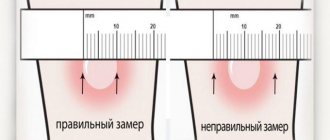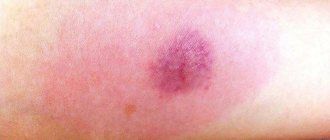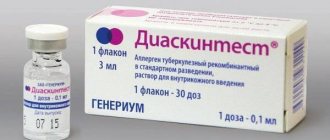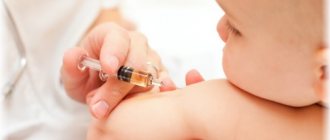The Mantoux test is used to measure the human body's immune response to tuberculin, a heat-treated, specially processed fragment of tuberculosis bacteria. Intradermal administration has been used for over 70 years worldwide. In adults, the test shows whether a person is infected with the tuberculosis bacillus or not. For children, the Mantoux test is used for a slightly different purpose.
The sample is injected into the top layer of skin by lifting the skin with a needle. Intradermal administration is used mainly for the forearm, for its middle part.
WHAT IS THE MANTOU REACTION
The Mantoux test is designed to provoke an immune response. It has nothing to do with vaccination, so it is incorrect to say that Mantoux is a vaccination. In order for the human body to respond to a microbiological invasion, the immune system must be familiar with these microorganisms. The immune system can only respond to threats with which it is already familiar. The immune system will not be able to recognize new infections until a person is vaccinated or has had a certain disease.
If the immune system is familiar with tuberculin bacteria, when they are introduced, immune cells will attack tuberculin. In this case, a local inflammatory reaction will be observed.
Is it possible to do Mantoux and BCG at the same time according to the vaccination calendar?
The vaccination schedule does not imply the simultaneous performance of the Mantoux test and BCG. According to the regulations, if a child is not given BCG for some reason in the maternity hospital, then the procedure can only be performed after the Mantoux test has been performed.
This rule applies to cases where the BCG vaccination was not given until the child was two months old.
Vaccination after tuberculin administration should be carried out no earlier than 3 days and no later than 2 weeks. A prerequisite is that the Mantoux result must be unconditionally negative.
WHY DO THEY MAKE MANTU FOR CHILDREN?
There are several purposes for testing in childhood:
- Identification of uninfected patients for subsequent vaccination. Using a test, you can find out whether there is a response to tuberculin.
- Checking the dynamics of test results over several years. Using this information, one can determine the Mantoux “turn”, the presence of tuberculosis with a high degree of probability.
- Determination of a severe reaction that requires additional research.
In adult patients, the test is a reliable, sensitive test for determining the presence of the tuberculosis pathogen in the body.
Children begin testing at age 1 and finish testing at age 15. Mantoux is administered annually.
How often is Mantoux given to adults, and up to what age is it done?
Mantoux is not often given to adults, but only according to indications:
- the doctor has good reason to suspect the patient has extrapulmonary tuberculosis;
- the patient has recently undergone radiotherapy, radiography or any other radiation exposure;
- a person undergoes long-term treatment with certain medications (glucocorticosteroids, immunosuppressants).
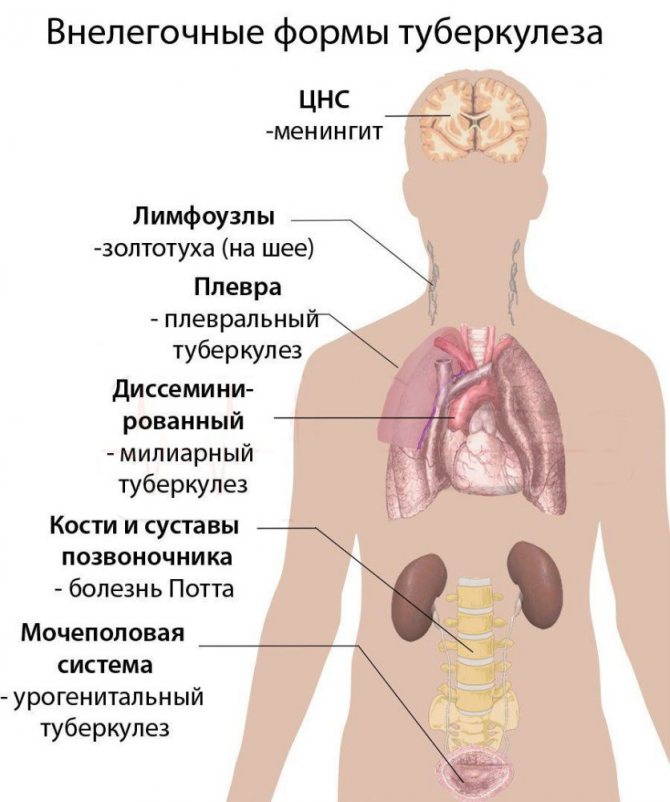
After the age of 16-18 years, the Mantoux test is done extremely rarely, unless there are clear indications for it. After reaching the age of 35, such manipulation is performed only at the request of doctors.
Most often, Mantoux is given to those adults who are at risk - they are in constant contact with patients, live in a region that is unfavorable specifically for the incidence of tuberculosis, work in correctional colonies, and so on.
Due to age-related changes in the human body, the Mantoux test is considered to be of little information; it is advisable to rely on fluorography data in diagnosis.
COMPOSITION OF THE PREPARATION
To perform testing, tuberculin tests are used, consisting of:
- Chemically, thermally treated fragments of bacteria.
- Twin-80 – stabilizer.
- Phenol is a preservative.
- Potassium and sodium phosphates.
- Sodium chloride.
- Water.
As a rule, many parents are frightened by the presence of phenol in the composition of the drug. Yes, it is a toxin, but its presence in the sample is minimal. Therefore, there is no harm to health. Low concentrations of the substance in medical preparations are justified for use.
NORMAL FOR CHILDREN
After the first BCG vaccination, children retain anti-tuberculosis immunity for up to 7 years. How well it is preserved depends on the diameter of the scar after the test. It remains on the left shoulder. If there is no such round mark, this means that the BCG vaccination was not given, and the child does not have immune protection against tuberculosis.
Table 1. Preservation of anti-tuberculosis immunity after BCG vaccination depending on the diameter of the post-vaccination scar.
| Diameter post-vaccination rib, mm. | Duration of anti-tuberculosis immunity, years |
| up to 2 | until 3 |
| up to 4 | up to 4 |
| until 6 | up to 5 |
| 8 or more | up to 7 |
The age of the patient decides what the reaction to the test should be:
- 1 year. The papule is 5-10 mm in size, regardless of the size of the post-vaccination scar.
- 2-6 years. The intensity of anti-tuberculosis immunity reaches its maximum by the age of 2 years. If the scar is larger than 8 mm, the papule can reach 16 mm. After 3 years, the immune response dies down. However, at 4-5 years old, children still have a positive or questionable reaction, and the size of the papule at the age of 4-6 years is considered normal if it does not exceed 10 mm.
- 6-7 years. At this age, patients have a negative or questionable response to the test. A negative result is a signal about the need for re-vaccination. Routine revaccination is performed at 7 years of age.
7-14 years old. As after the first vaccination, the intensity of immunity remains in the first 3 years, and then begins to subside. Therefore, the response to injected tuberculin fades by the age of 10 years. By the age of 13-14, patients have a negative, questionable response to the test.
Table 2. Correlation between the normal size of the papule and the size of the post-vaccination scar in children aged 3-5 years.
| Diameter of post-vaccination scar, mm. | Papules norm, mm |
| up to 2 | no reaction |
| up to 4-6 | 5-6 |
| 6 or more | to 10 |
When is TB testing performed?

The first vaccination against tuberculosis, if there are no contraindications, is given to the baby in the maternity hospital a couple of days after birth. Tuberculosis testing will then be done at 1 year. If the BCG vaccination is given to a baby older than 2 months, then it will be preceded by a check. It is designed to identify whether there was an infection during this time.
Healthy children after 1 year of age are given an injection once a year until they reach 15-16 years of age.
REACTION TO TEST BY DAY
A reaction to Mantoux is observed in patients on the second day after the test. The body may react with the formation of a papule and/or redness. The maximum immune response can most often be noted on the third day. The reaction can be negative, false negative or positive, false positive:
- Negative. The absence of any reaction indicates that the immune system is not familiar with tuberculosis pathogens. The patient does not suffer from tuberculosis in any form. If a child has had less than 5 years since vaccination, a negative reaction is a bad signal. He reports that the immune system does not remember danger. If more than 5 years have passed, then the lack of reaction is a plus. This is a sign that the child is not sick. The same rule works for adults.
- False negative. This reaction can be observed in cases where a person’s immune system stops responding to injected tuberculin over the years.
- Positive. We can talk about such a reaction to the test if the papule is larger than 5 mm in diameter. It is necessary to analyze a positive result in children based on a combination of factors. It is necessary to evaluate the dynamics of the sample over the past years, the very nature of the papule, the size of the scar, and how long ago the vaccination was performed. If the reaction is positive in an adult, this is a signal of almost 100% probability of infection.
- False positive. This category includes questionable answers - redness of any size, papules with a diameter of less than 4 mm. A false positive reaction can occur in a number of cases. For example, when a person has recently undergone any vaccination or has had an infectious disease. Also, a questionable reaction occurs with a skin allergic reaction, etc. To make sure that there is no need to panic in case of a false positive result, it is necessary to check whether the patient has contacts with tuberculosis patients, the situation in the region, and whether the incidence threshold has been exceeded.
How is a tuberculin test performed?
After the doctor examines the child and gives permission, the child is sent to the treatment room, where the procedure will take place. For young patients, the test is done in a clinic at their place of residence, for preschool children and school students - in an educational institution, without interrupting the learning process.
Tuberculin is injected subcutaneously, from the inside of the forearm. For injection, a syringe with a thin needle is used. For a skin test, 0.1 ml of the drug is sufficient. Immediately after administration, a small compaction, the so-called button, forms at the injection site, which resolves after some time.
72 hours after administration of the drug, the physician evaluates the resulting reaction.
There are four types of reaction:
- negative - when there is no redness or swelling at the injection site;
- doubtful or controversial - the size of the papule is no more than 4 mm, slight redness and hyperemia are possible;
- positive - can be mild, moderate or pronounced. The severity of the reaction is determined by the size of the papule: from 5 to 9 mm for mild ones and 15-16 mm for severe ones;
- excessive (hyperergic) - papule more than 16 mm, vesiculo-necrotic manifestations are possible.
It is also possible to obtain a false positive reaction. This happens most often if the rules of the procedure were violated.
In addition to the above indicators of the Mantoux reaction, there is also such a thing as the turn of the tuberculin test. This indicator indicates a sharp change in the test result compared to the result of previous years. Identification of a tuberculosis test, as well as a hyperergic reaction, serves as a reason to refer the patient for a consultation with a phthisiatrician.
If moderate and severe indicators of the Mantoux reaction have been observed for several years, consultation with an infectious disease specialist and a phthisiatrician is also necessary. The patient will be prescribed a repeat test and additional examinations: tests, x-rays of the lungs.
Any reaction should only be assessed by a qualified healthcare professional. A positive reaction does not mean that the patient definitely has tuberculosis. Additional examination is necessary.
SIDE EFFECTS, COMPLICATIONS
An excessive response of the patient’s body to the administered drug is the cause of the main side effects. These include:
- Allergy. This reaction is possible in patients of any age, since tuberculin is an allergen.
- Temperature. With high sensitivity to the drug, a slight increase in temperature may be observed.
- Hyperergic reaction. Formation of papules larger than 17 mm in diameter. This answer indicates the presence of tuberculosis infection in the body.
- Cough. Traditionally, this side effect is not associated with the administration of the sample.
- The papule itches. It is necessary to avoid scratching the papule; the tuberculin injection site itself may itch.
Methodology
Despite the fact that most people took the Mantoux test every year during their school years, few people know exactly how it works. The mechanism is actually simple. A special extract, which is part of the bacterium, is injected subcutaneously into the body. At the same time, a person is not able to become infected with tuberculosis. This extract is a strong allergen that provokes an immune response.
After the tuberculin test is administered, the following processes occur in the body:
- Lymphocytes are sent to the site of tuberculin injection.
- Lymphocytes that have “experience” of encountering Mycobacterium tuberculosis begin to act most of all.
- The spot at the injection site grows depending on the number of T lymphocytes present.
If the test is carried out correctly, it is given before any preventive vaccinations. This is done to ensure accurate results. According to the rules, it doesn’t matter which hand you put the Mantoux test in, the main thing is to change them every year. The place where the injection is given is between the wrist and elbow. Caring for a papule is simple - it is advisable not to scratch it or get it too wet. Also, do not smear with any medications, for example, brilliant green or iodine. The result is taken after 72 hours and compared with the previous ones.
By following just a few rules for caring for the injection site, you can guarantee accurate results for the presence of Mycobacterium tuberculosis. However, it is not dangerous to humans and with a high degree of probability detects the presence of a pathogen.
Decoding the results
Three days after the injection, the physician needs to measure the spot around the injection and record the results. After this, you can draw conclusions and compare the sizes with those recorded last year.
When deciphering the results, the following indicators are used:
- Negative result. It is fixed when the spot size is less than 1 mm. This indicates that the person has not had contact with Mycobacterium tuberculosis in his life. Sometimes such a reaction occurs if a person has recently become ill and the body has not produced lymphocytes against tuberculosis. A similar reaction is recorded in HIV patients.
- Questionable reaction. Redness around the injection does not exceed 4 mm. There may be a small number of pathogens in the body; additional research is required.
- Positive reaction. Size 5-15 mm. This indicates the presence of bacteria in the body and the presence of immunity to tuberculosis.
- Hyperergic reaction. Occurs in people prone to allergies, as well as in those who have recently suffered an infectious disease. The size of the red spot in this case is more than 16 mm. This reaction indicates a large number of pathogens in the human body.
In any case, after recording a positive or questionable result, the examinee is sent to a phthisiatrician. For an accurate reaction, it is necessary to compare the indicators with those on the map. For example, if a questionable reaction appears over several years, then it is worth checking and ordering additional tests. It should be noted that a person who has had tuberculosis can have a positive result, since his body retains immunity, which means an allergic reaction will occur.
If you do not rub or wet the injection, then after three days you can evaluate the result by measuring the pulp. It will show whether the body has lymphocytes that have encountered tuberculosis bacteria.
Contraindications and possible negative consequences
Recently, many parents are refusing the Mantoux test because they have heard a lot about the negative consequences. Since the tuberculin test is essentially an allergen, side effects sometimes occur.
Among the most common are:
- disturbances of the gastrointestinal tract in the form of constipation;
- headache and dizziness;
- temperature rise up to 40 degrees;
- nausea, even vomiting is possible;
- reactions at the injection site in the form of rash and itching;
- asthmatic attacks.
Immediately before the test, it is desirable that the person does not suffer from infectious diseases or have an elevated body temperature. For bronchial asthma and epilepsy, other diagnostic and testing methods are used. You cannot do a test earlier than a month after any vaccination. If a child is prone to allergies, it is recommended that he be prescribed antihistamines before the Mantoux test. In order to avoid unnecessary reactions, it is not recommended to introduce new foods into the diet before the test to avoid unnecessary irritation.
Any medical procedure has side effects. Therefore, if the child is a little lethargic and drowsy after the test, this is a completely normal reaction. In addition, you may feel slightly unwell and even have a fever. This is not scary, the main thing is not to wet the sample so as not to affect the results. In case of sudden changes, you can consult a specialist.
Tuberculosis has been with humanity throughout its history. Enormous variability and ability to adapt helps mycobacterium tuberculosis to get used to new antibiotics. Therefore, the main weapon of humanity remains prevention and early diagnosis. The most reliable are the Mantoux test, as well as the Diaskintest, which will indicate the presence and activity of bacteria in the body.
ALTERNATIVE TO MANTOU SAMPLE
For those who want to avoid the Mantoux test, there is an alternative option. The Diaskintest test has proven itself because it is less likely to produce false positive results. However, it produces false negative reactions more often. As a rule, Mantu is used as a basic test, and Diaskin as a clarifying test.
The Mantoux test is used to test the body's response to tuberculosis bacteria - whether the immune system can fight them. This test can give a false positive result in 80% of cases. But the diagnosis is confirmed in no more than 1% of cases in children. For adults, Mantoux is the main, most accurate and sensitive method for detecting tuberculosis infection.
Contraindications for testing
Any medical procedure has its contraindications. There are certain groups of people who should not be given the Mantoux test. Most often these are people with an allergic reaction. If you do not pay attention to contraindications, you can obtain incorrect data or harm the patient’s body.
The main contraindications are:
- The first month after the blood transfusion procedure. This group also includes those who took drugs with blood components.
- Graft. Usually the vaccine is given after the results of the Mantoux test.
- Epilepsy. It is recommended to use other diagnostic methods for this disease.
- Skin diseases.
- If you have allergies, you must take antihistamines for several days before and after the test.
Which hand Mantoux is made on is usually written down on the card along with the series and number of the drug. But before administering the test, the doctor must carefully study the card and find out whether there are any contraindications to the test. In addition, it is necessary to determine when the last tuberculosis vaccination was performed. If a month has not passed since then, the test results may be false.
There are few contraindications to tuberculin examinations. Basically they are not permanent, you just have to move them over time. But it is necessary to take into account the presence of contraindications, otherwise you may get incorrect results.
The Mantoux test is the most famous and fairly effective method for diagnosing tuberculosis. According to the results of this test, it is possible to determine whether the body contains Koch's bacillus, which is the causative agent of tuberculosis. It should be understood that the Mantoux test is not a vaccination, it is a test for the presence of a pathogen. If the test result is positive, it means there is a tuberculosis bacillus in the body, and the person needs examination followed by treatment. The Mantoux test is performed on children of school age every year without fail. In this case, parents have the right to refuse, but in any case it is necessary to conduct a diagnosis. If tuberculosis is not detected in the early stages, the disease can progress, and this will complicate treatment. Since our country is not free from tuberculosis, the Mantoux test continues to be performed annually, and the result is examined over time.


